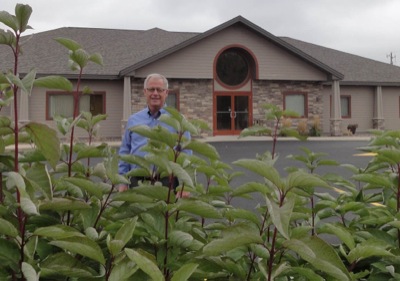
LEFT: Tim Hoff, co-owner of Hoff Funeral Services in St. Charles, Minnesota, found rain gardens were easy to add to his building project. CENTER: The parking lot is sloped so water flows to beds of native plants, where it is absorbed. RIGHT: Well-placed plantings are enjoyed by visitors, neighbors and staff.
When a business or commercial developer takes on a construction project, a storm water plan and permit are required in most communities. It’s one more thing for the to-do list, but most businesses find the plan becomes a benefit—particularly if they approach it as a business opportunity.
Local codes in St. Charles require on-site water infiltration. For Hoff Funeral Services that meant no runoff from parking lot to streets or neighbors’ yards.
To make that happen, co-owner Tim Hoff, building contractor Greg Feuerhelm and parking lot contractor Steve Pearson took a look at the contours of the property. They noted water movement on the land, desired size for the hard surface area, best locations for infiltration basins, and slope needed to move water to basins. After a plan was in place, lot paved, and soil graded, Winona Nursery turned simple trenches into business assets with stone and native plants.
“It wasn’t hard,” says Hoff, laughing. “I just had to pay for it!”
Jokes aside, Hoff encourages business owners to look beyond immediate expense to real benefits down the road. “It might cost a little more in the beginning, but we need to think about where water goes and how to keep it clean,” he says.
Some Hoff Funeral Service neighbors wondered about the rain gardens at first, but say they look fantastic now, and they work! And the tough native plants chosen for the project require little care—just once-a-year trimming and a quick trip to the City’s compost site.


3 Rain Garden Benefits
1) Water drains from high-traffic paved areas to the landscape.
2) If a storm water utility exists, fees are primarily eliminated.
3) Plantings attract positive attention, create goodwill, and add beauty to the community.
Rain gardens are shallow basins where water stays just long enough to soak in, rather than run across hard surfaces to a storm drain, ditch or stream. Native plants add beauty and soak up even more water.

